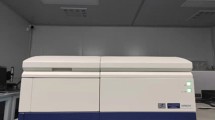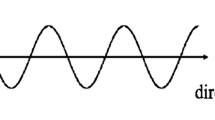Abstract
In the present research, we propose a novel measuring method of ultrasonic cavitation by naked-eye based on the conversion of ferrous ion to ferric ion and chromogenic reaction between ferric and thiocyanate. The effects of different conditions affecting cavitation were investigated. Experiments show that this method can effectively measure the strength of the cavitation field of the system, and is simple to operate, and the results are intuitive, and the cavitation strength can be obtained quickly. The effects of size and concentration of solid particles on ultrasonic cavitation are also studied by using micro-SiO2 as the typical representativeness. It was found that the addition of solid particles could reduce the heterogeneous cavitation threshold. The results provide a basis for the industrialization of ultrasonic chemistry, especially the strengthening of the reaction process of heterogeneous systems under ultrasound.










Similar content being viewed by others
References
An Y (2011) Formulation of multibubble cavitation. Phys Rev E 83(6):066313
Chemat F, Rombaut N, Sicaire AG, Meullemiestre A, Fabiano-Tixier AS, Abert-Vian M (2017) Ultrasound assisted extraction of food and natural products. Mechanisms, techniques, combinations, protocols and applications. Rev Ultrason Sonochem 34:540–560
Copete-Pertuz LS, Serna-Galvis EA, Plácido J, Torres-Palma RA, Mora-Martínez AL (2021) Coupling chemical oxidation processes and Leptosphaerulina sp. myco-remediation to enhance the removal of recalcitrant organic pollutants in aqueous systems. Sci Total Environ 772:145449
Corzo BA, Suárez-Herrera MF (2018) Effect of carbon tetrachloride on the luminol sonochemiluminescence reaction kinetics during multibubble cavitation. Ultrason Sonochem 48:281–286
Esposito C, Mendez MA, Steelant J, Vetrano MR (2021) Spectral and modal analysis of a cavitating flow through an orifice. Exp Therm Fluid Sci 121:110251
Fricke H, Hart EJ (1935) The oxidation of Fe++ to Fe+++ by the irradiation with X-rays of solutions of ferrous sulfate in sulfuric acid. J Chem Phys 3(1):60–61
Giesecke T, Hynynen K (2003) Ultrasound-mediated cavitation thresholds of liquid perfluorocarbon droplets in vitro. Ultrasound Med Biol 29(9):1359–1365
Guo P, Wang S, Zhang L (2019) Selective removal of antimony from refractory gold ores by ultrasound. Hydrometallurgy 190:105161
Harrabi M, Ammar HB, Mbarki K, Naifar I, Yaiche C, Aloulou F, Elleuch B (2018) Ultrasonic power improvement of flumequine degradation effectiveness in aqueous solution via direct and indirect action of mechanical acoustic wave. Ultrason Sonochem 48:517–522
Hart EJ, Henglein A (1985) Free radical and free atom reactions in the sonolysis of aqueous iodide and formate solutions. J Phys Chem 89(20):4342–4347
Holland CK, Apfel RE (1990) Thresholds for transient cavitation produced by pulsed ultrasound in a controlled nuclei environment. J Acoust Soc Am 88(5):2059–2069
Yao J, Liu W, Zhou L (2018) Formation of bromate in aqueous solution in the presence of br - under ultrasonic irradiation. Chongqing Daxue Xuebao/J. Chongqing University 41(6):84–90
Kentish S, Ashokkumar M (2011) The physical and chemical effects of ultrasound. In: Feng H, Barbosa-Canovas G, Weiss J (eds) Ultrasound technologies for food and bioprocessing. Springer, New York, pp 1–12
Kimura T, Sakamoto T, Leveque JM, Sohmiya H, Ando T (1996) Standardization of ultrasonic power for sonochemical reaction. Ultrason Sonochem 3(3):S157–S161
Koda S, Kimura T, Kondo T, Mitome H (2003) A standard method to calibrate sonochemical efficiency of an individual reaction system. Ultrason Sonochem 10(3):149–156
Kumar SS, Balasubrahmanyam A, Shyam SP, Gogate PR, Deshpande VD, Shukla SR et al (2009) Characterization of sonochemical reactor for physicochemical transformations. Ind Eng Chem Res 48(21):9402–9407
Liu LY, Wen JJ, Yang Y, Tan W (2013) Influence of particle addition on ultrasonic cavitation field. Chem Ind Eng 30(1):59–66
Maleki A (2018) Green oxidation protocol: selective conversions of alcohols and alkenes to aldehydes, ketones and epoxides by using a new multiwall carbon nanotube-based hybrid nanocatalyst via ultrasound irradiation. Ultrason Sonochem 40:460–464
Mason TJ, Lorimer JP (2002) Applied sonochemistry: the uses of power ultrasound in chemistry and processing. Appl Sonochem 9:885–900
Masuda H, Ebata A, Teramae K, Hishinuma N (1993) Alteration of thermal conductivity and viscosity of liquid by dispersing ultra-fine particles (dispersion of γ-al2o3, sio2 and tio2 ultra-fine particles). Netsu Bussei 7(4):227–233
Méndez-Arriaga F, Torres-Palma RA, Pétrier C, Esplugas S, Gimenez J, Pulgarin C (2008) Ultrasonic treatment of water contaminated with ibuprofen. Water Res 42(16):4243–4248
Merouani S, Ferkous H, Hamdaoui O, Rezgui Y, Guemini M (2015) A method for predicting the number of active bubbles in sonochemical reactors. Ultrason Sonochem 22:51–58
Mirzadeh E, Akhbari K, Phuruangrat A, Costantino F (2017) A survey on the effects of ultrasonic irradiation, reaction time and concentration of initial reagents on formation of kinetically or thermodynamically stable copper (I) metal-organic nanomaterials. Ultrason Sonochem 35:382–388
Murshed SMS, Leong KC, Yang C (2008) Investigations of thermal conductivity and viscosity of nanofluids. Int J Therm Sci 47(5):560–568
Nomura H, Koda S, Yasuda K, Kojima Y (1996) Quantification of ultrasonic intensity based on the decomposition reaction of porphyrin. Ultrason Sonochem 3(3):S153–S156
Reza DCS, Jorfi S, Ramezani H, Purfadakari S (2016) Ultrasonically induced ZnO–biosilica nanocomposite for degradation of a textile dye in aqueous phase. Ultrason Sonochem 28:69–78
Rong L, Kojima Y, Koda S, Nomura H (2001) Simple quantification of ultrasonic intensity using aqueous solution of phenolphthalein. Ultrason Sonochem 8(1):11–15
Santos HM, Lodeiro C, Capelo-Martínez JL (2009) The Power of Ultrasound. Wiley‐VCH Verlag GmbH & Co. KGaA
Šarc A, Stepišnik-Perdih T, Petkovšek M, Dular M (2017) The issue of cavitation number value in studies of water treatment by hydrodynamic cavitation. Ultrason Sonochem 34:51–59
Sato M, Itoh H, Fujii T (2000) Frequency dependence of H2O2 generation from distilled water. Ultrasonics 38(1–8):312–315
Sivakumar M, Pandit AB (2001) Ultrasound enhanced degradation of Rhodamine B: optimization with power density. Ultrason Sonochem 8(3):233–240
Torres RA, Pétrier C, Combet E, Carrier M, Pulgarin C (2008) Ultrasonic cavitation applied to the treatment of bisphenol A. Effect of sonochemical parameters and analysis of BPA by-products. Ultrason Sonochem 15(4):605–611
Wang W, Ma X, Xu Y, Cao Y, Jiang Z, Ding T et al (2015) Ultrasound-assisted heating extraction of pectin from grapefruit peel: optimization and comparison with the conventional method. Food Chem 178(Jul. 1):106–114
Xu X, Cao D, Wang Z, Liu J, Gao J, Sanchuan M, Wang Z (2019) Study on ultrasonic treatment for municipal sludge. Ultrason Sonochem 57:29–37
Yasuda K, Torii T, Yasui K, Iida Y, Tuziuti T, Nakamura M, Asakura Y (2007) Enhancement of sonochemical reaction of terephthalate ion by superposition of ultrasonic fields of various frequencies. Ultrason Sonochem 14(6):699–704
Acknowledgements
The authors are grateful to the National Natural Science Foundation of China (Nos. U2002214, U1702252,) and the Natural Science Foundation of Yunnan Province (2019FA022).
Author information
Authors and Affiliations
Corresponding authors
Ethics declarations
Conflict of interest
No conflict of interest exists in the submission of this manuscript, and the manuscript is approved by all authors for publication.
Additional information
Publisher's Note
Springer Nature remains neutral with regard to jurisdictional claims in published maps and institutional affiliations.
Rights and permissions
About this article
Cite this article
Liu, J., Wang, S., Liu, C. et al. A naked-eyes detection method and the influence of solid particles for the ultrasonic cavitation. Chem. Pap. 75, 6389–6397 (2021). https://doi.org/10.1007/s11696-021-01805-6
Received:
Accepted:
Published:
Issue Date:
DOI: https://doi.org/10.1007/s11696-021-01805-6




